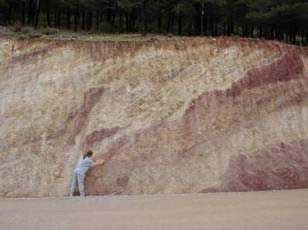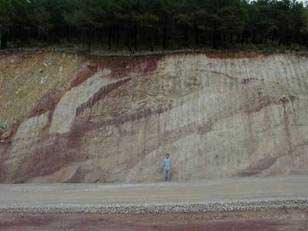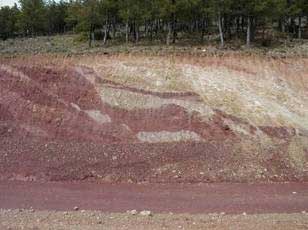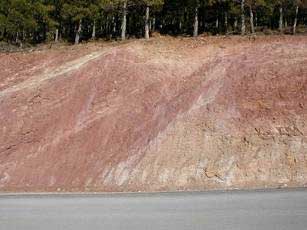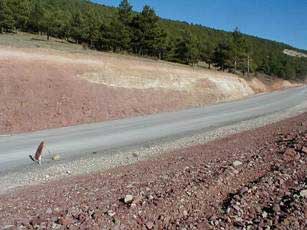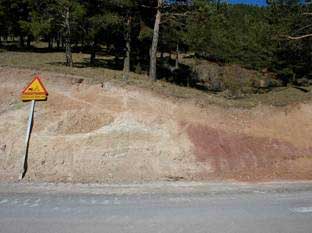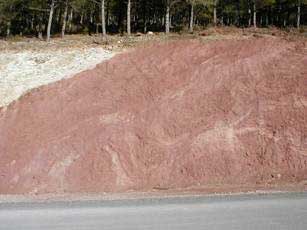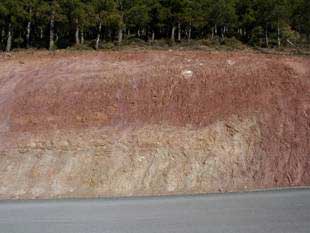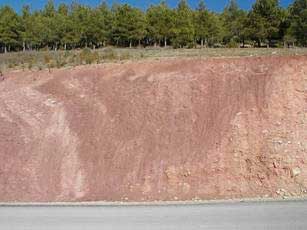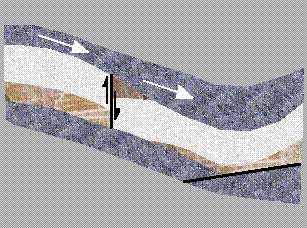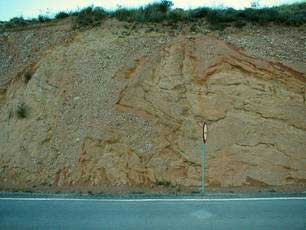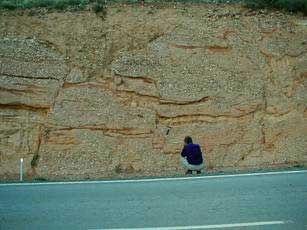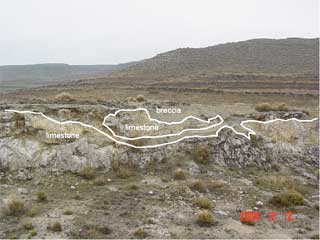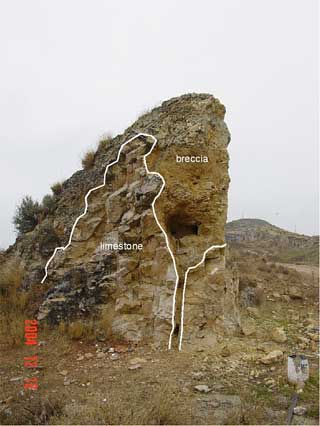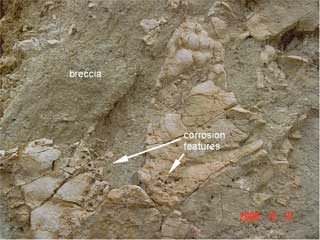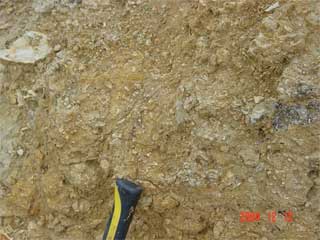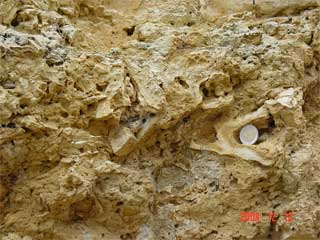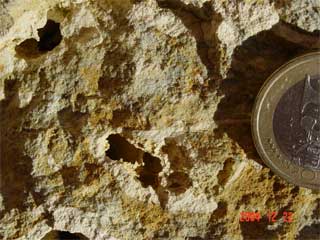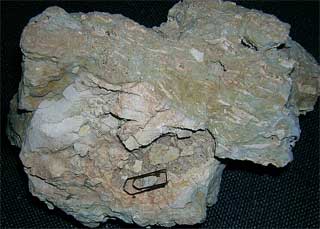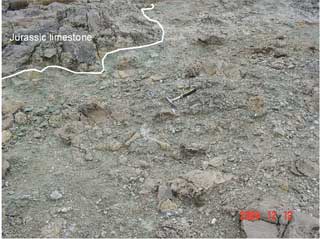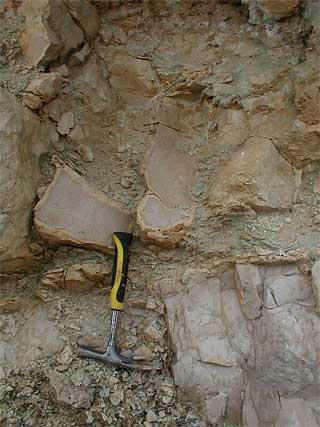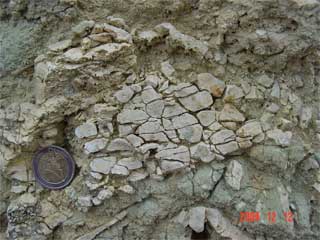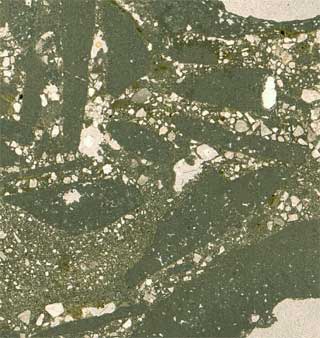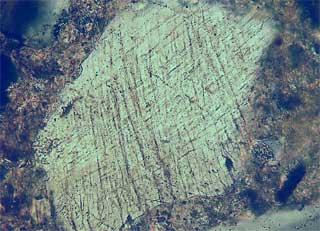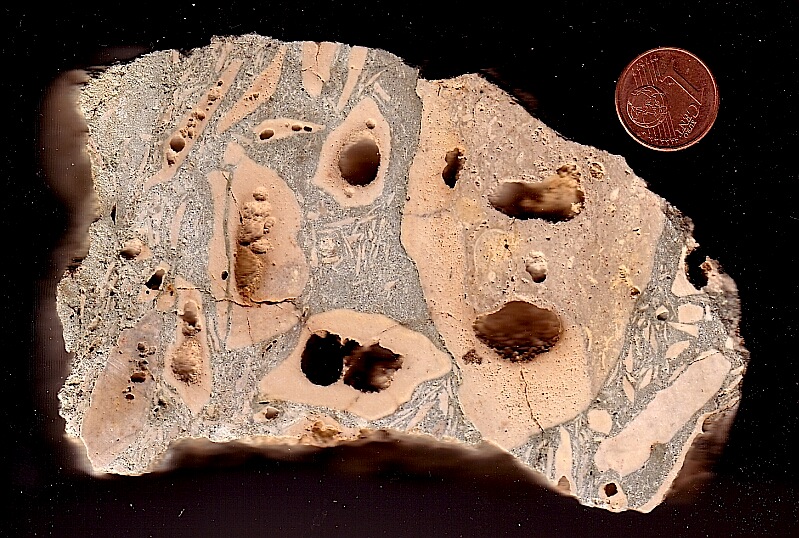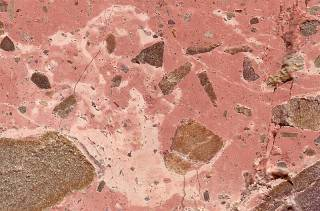In the 1 July 2012 issue of the Earth and Planetary Science Letters journal an article has been published on a suspected 100 km sized impact structure that on verification would document the oldest cosmic collision on Earth so far known.
YDB impact: a new chapter
… or a “Requiem” for the rejection of the hypothesis?
YDB abbreviates Younger Dryas Boundary. The Younger Dryas stadial signifies a sharp onset of a period of cold climatic conditions in Earth’s history lasting roughly 1,000 years between about 11,000 and 10,000 B.C. at the end of the Pleistocene (the “Ice Age”) and the beginning Holocene.
The causes of this event are controversially disputed, and they are conventionally ascribed to perturbations of North Atlantic circulation. In 2007, a new hypothesis on a giant meteorite impact Continue reading “YDB impact: a new chapter”
Chiemgau impact: a probable doublet meteorite crater in Lake Chiemsee
Kord Ernstson (2012)
Since a few years there is evidence of a doublet meteorite crater at the bottom of Lake Chiemsee (Fig. 3) in the Chiemgau meteorite crater strewn field. The search for a suspected impact into the lake was originally based on reports of fishermen about unusual sharp-edged large stones at the lake bottom that had damaged their fishnets. Such stones are in fact foreign matter in the lake. A general echo sounder campaign, followed by a detailed survey veritably revealed a peculiar structure, likewise a foreign element in the lake (Fig.1), with all evidence of a rimmed doublet crater. The similarity to meteoritic dual craters on Mars that formed synchronously by twin projectiles is striking (Fig. 2).
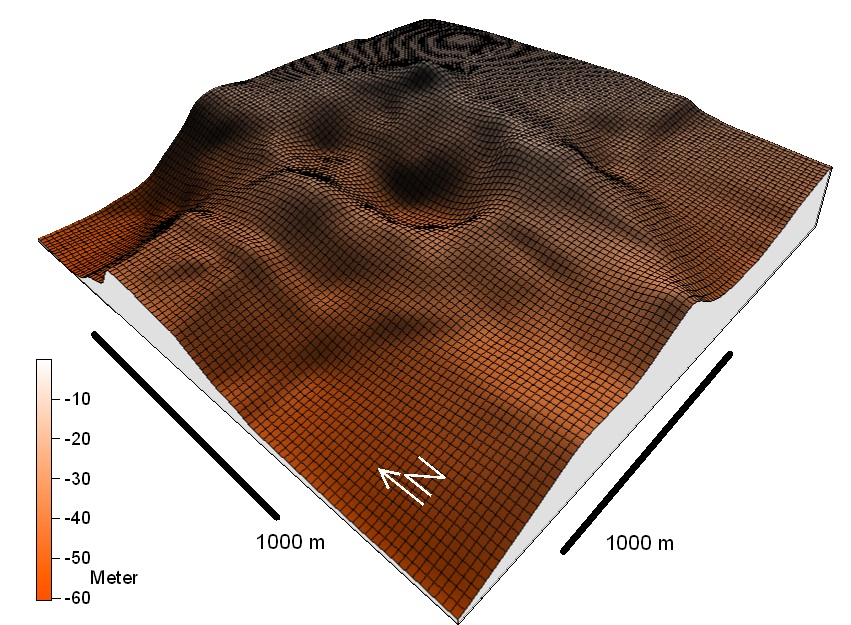 Fig. 1. The proposed meteorite doublet crater at the bottom of Lake Chiemsee from detailed SONAR echo sounder measurements. Meter scale indicates water depth.
Fig. 1. The proposed meteorite doublet crater at the bottom of Lake Chiemsee from detailed SONAR echo sounder measurements. Meter scale indicates water depth.
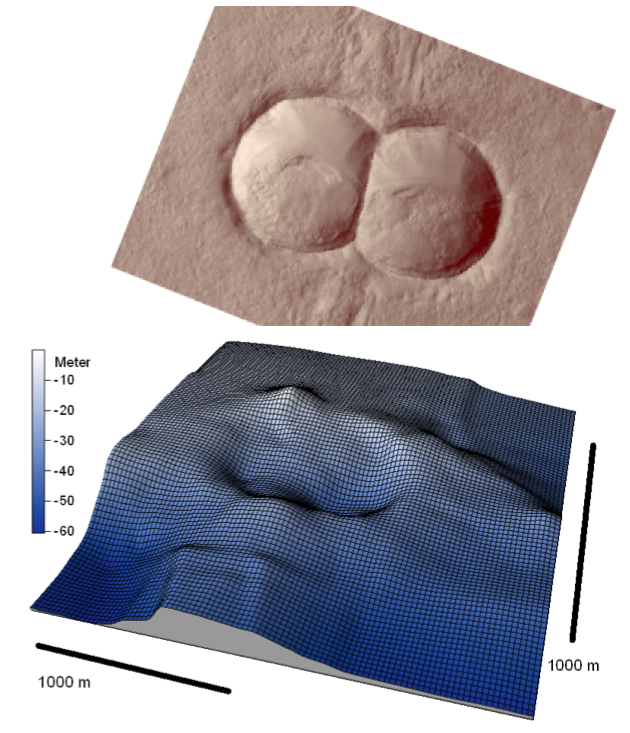 Fig. 2. Meteoritic dual craters on Mars (image source NASA) and a counterpart at the bottom of Lake Chiemsee: A remarkable similarity. The more diffuse contours of the Lake Chiemsee craters is not surprising because of the impact into water and a loosely bound and water-saturated sedimentary target below.
Fig. 2. Meteoritic dual craters on Mars (image source NASA) and a counterpart at the bottom of Lake Chiemsee: A remarkable similarity. The more diffuse contours of the Lake Chiemsee craters is not surprising because of the impact into water and a loosely bound and water-saturated sedimentary target below.
More evidence of a meteorite impact into the lake came up with the frequent finds of pumice at the shore of Lake Chiemsee (more can be read HERE) and the observation of very young tsunami deposits uncovered in the environs of the lake (see HERE and HERE).
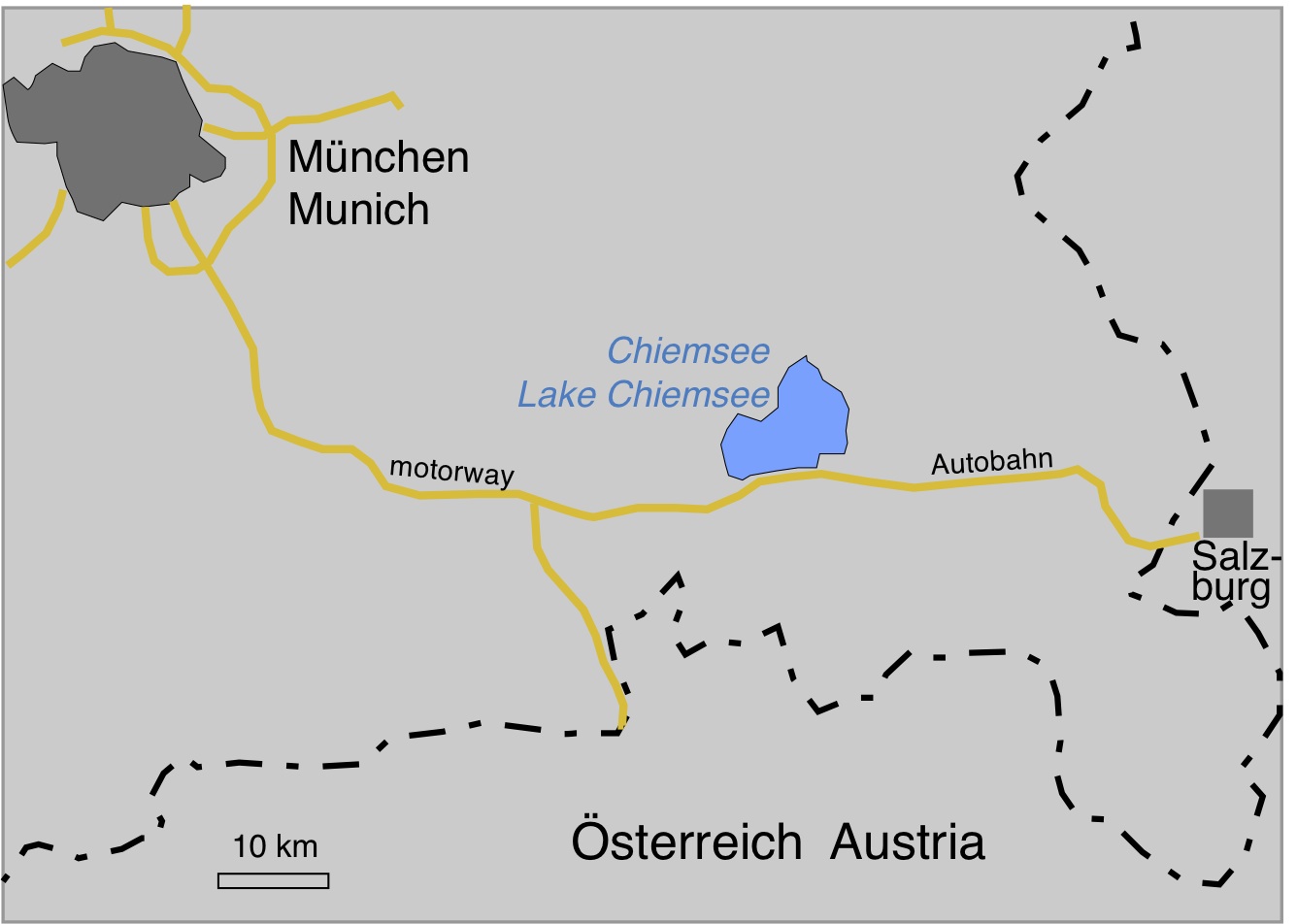 Fig. 3. Location map for the Lake Chiemsee in southeast Bavaria hiding the probable meteorite doublet crater.
Fig. 3. Location map for the Lake Chiemsee in southeast Bavaria hiding the probable meteorite doublet crater.
Unfortunately, because of the deep water the crater is not accessible directly.
Earthquakes and meteorite craters: Rock liquefaction phenomena and the Chiemgau impact.
The impact of cosmic bodies to produce large impact craters is related with the propagation of seismic waves which may release energies comparable to strongest earthquakes, and even beyond that. It is obvious that similar processes and well-known drastic deformations may result in the ground and at the earth’s surface.
In this context, W. Alvarez and coauthors (Alvarez W., Staley E., O’Connor D., Chan M.A., Synsedimentary deformation in the Jurassic of south-eastern Utah, a case of impact shaking? Geology, 1998, 26, 579-582) went into an interesting question when they related characteristic deformations in exposed older geological layers with a possible meteorite impact in a past geologic epoch thus pointing to the Upheaval Dome impact structure (Utah, USA) and distant rock liquefaction phenomena. Rock liquefaction is an established process during strong earthquakes which can lead to enormous modifications of the earth’s surface and catastrophic damage when the seismic shock affects water-saturated uncemented rocks. For the study of earlier earthquakes in the geologic past (paleoseismicity), observations in older layers may be important, and Alvarez had now pointed to the possibility that fossil sedimentary liquefaction features need not necessarily have originated from earthquakes but may be related with former large impact events. A critical debate, however, submitted that in the special case such a context of the relatively small 6 km-diameter Upheaval Dome impact structure and the geological outcrop some 260 km apart must be questioned.
Now for the first time, a compelling direct evidence for the relation of a large meteorite impact with distinct rock liquefaction features has been established. The recently printed article
describes the first geologic and geophysical investigations of the so-called “Thunderhole” (in German: Donnerloch) phenomenon in the region of the town of Kienberg north of Lake Chiemsee in Southeast Bavaria (Germany).
Fig. 1. A freshly caved-in and a somewhat older thunderhole near the town of Kienberg north of Lake Chiemsee. Strikingly different from customary and well known sink holes e.g. in karst areas, the thunderholes exhibit a highly energetic rock mass transport from the bottom up before collapse, which is typical for liquefaction processes.
The authors conclude that the innumerable enigmatic sudden sinkhole cave-ins having happened in living memory originate from late and even today acting processes of an earlier shock-induced underground rock liquefaction known from strong earthquake shocks. The geologically prominent underground structures that have now been uncovered are considered the result of impact shocks in the course of the formation of the Chiemgau meteorite crater strewn field (Chiemgau impact), and a comparison is made with the famous widespread and strong rock liquefaction features in the large region affected by the catastrophic 1811/1812 New Madrid (Missouri) earthquake series.
More detailed information about the geophysical measurements (resistivity and induced polarization (IP) soundings) of the thunderhole structures was given in a presentation at the 2011 Fall Meeting of the American Geophysical Union (AGU) in San Francisco:
The poster may be clicked here.
Fig. 2. From the geophysical investigation of the impact-induced thunderholes in the Chiemgau impact event. The geoelectrical measurements of induced polarization on a profile across an active depression as a precursor of a future thunderhole reveal perfectly clear the intrusion paths bottom up as a document of impact liquefaction.
Mars on Earth
ESA’s Mars Express has returned new images of an elongated impact crater in the southern hemisphere of Mars. Probably, the crater was caused by a train of projctiles and thus may be considered a model for the formation of the Rubielos de la Cérida elongated impact basin in Spain.
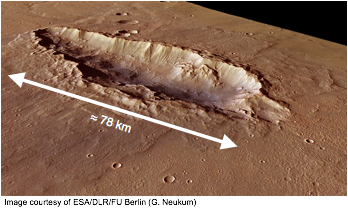
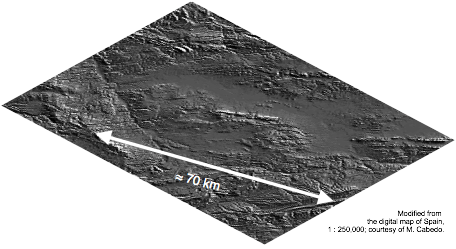
Rubielos de la Cérida impact basin. For comprehensive information click here.
Rubielos de la Cérida impact basin: New impact breccia dikes in Paleozoic silicate rocks
Breccia dikes (dike breccias) are a prominent feature in impact structures, and they have told us a good many about the processes of impact cratering. Among the yet known roughly 200 terrestrial impact structures, Azuara and Rubielos de la Cérida are providing the probably by far best insight into these fascinating geological configurations concerning abundance, exposure accessibility, and diversity with regard to geometry, dimensions and material (also see breccia/dikes; https://www.impact-structures.com/spain; rubielos-breccia-dikes). Recent extensive construction works (storage reservoir, freeway, railroad) near Lechago, Calamocha (CAL; see Fig. 1, red circle) have yielded quite a few nice geological exposures once more documenting the almost everywhere existing impact signature thus underlining that construction work in the large impact region of the Azuara and Rubielos de la Cérida structures may be a hard undertaking – as was impressively shown when the new Autovía freeway line had to cut through the strongly destroyed Paleozoic of the Iberian Chain in the northern rim zone of the Azuara impact structure between Daroca and Cariñena (click here https://www.impact-structures.com/impact-spain/the-azuara-impact-structure/the-2005-autovia-mudejar-geological-exposures/ “The 2005 Autovía Mudéjar geological exposures”).
Below we show images of some newly exposed impact breccia dikes near Lechago exhibiting their characteristic properties and, for comparison, similar dikes and dike systems from the companion Azuara impact structure (location in Fig. 1).
Focusing here on breccia dikes in Paleozoic silicate rocks bears in mind the frequent claim of some Spanish geologists, especially from the Zaragoza university, that the impact breccia dikes are all karst phenomena. Their confusion of breccia dikes with karst features, however, meets some difficulties in the case of silicate siltstones. Also fault breccias can clearly be excluded since these dikes are filled with allochthonous material as is typical for impact-induced highly energetic injection processes.

Fig. 1. Location map.

Fig. 2. Thick impact breccia dike cutting through Paleozoic siltstones at the new storage reservoir near Lechago (in the red circle of Fig. 1)

Fig. 3. For comparison: impact breccia dike in Paleozoic siltstones; road to Santuario de la Virgen de Herrera (1 in Fig. 1). Azuara impact structure.

Fig. 4. For comparison: thick impact breccia dikes cutting roughly perpendicular through the bedding of the Paleozoic siltstones. Autovía Mudéjar in course of construction; near Cariñena (2 in Fig. 1). Azuara impact structure.

Fig. 5. Large system of impact breccia dikes in Paleozoic siltstones at the new storage reservoir near Lechago. Note that the dominant set of dikes is cutting sharply across the bedding (see Fig. 6). In the top: Unfolded post-impact Tertiary sediments.

Fig. 6. Segment of the wall in Fig. 5.

Fig. 7. For comparison: System of impact breccia dikes cutting sharply through Paleozoic silicate rocks. Autovía Mudéjar in course of construction; near Cariñena (2 in Fig. 2). Azuara impact structure.
Regmaglypts on clasts from the Puerto Mínguez ejecta, Azuara multiple impact event (Spain)
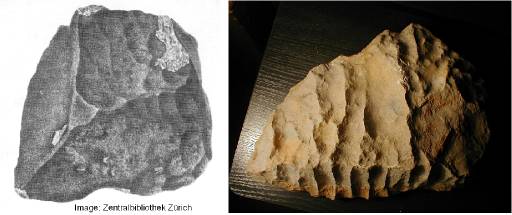
Fig. 1. Amazingly similar: Regmaglypts on the surface of the Tabor meteorite and on a limestone clast from the Puerto Mínguez impact ejecta.
Among the various deformation features exhibited by the carbonate clasts in the Puerto Mínguez ejecta deposit (striae, nail prints, grooves, rotated fractures, irregular fractures with complex bifurcations, mirror polish, etc), regmaglypted clast surfaces are a prominent feature (Fig. 1). For the first time described by K. Ernstson (2004), they establish clear evidences of an aerial transport of quite a few clasts of the ejecta.
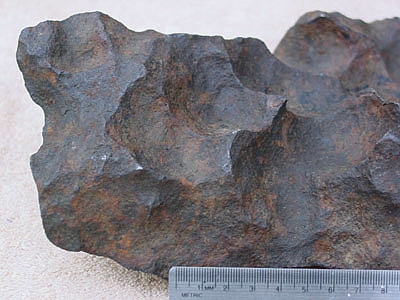
Source: Cascadia Meteorite Laboratory, Portland State University
Fig. 2. A Gibeon meteorite exhibiting distinct regmaglypts.
Regmaglypts (or thumbprints) are reliefs commonly reported for the surface of some meteorites (Figs. 1, 2). The depressions originate from dynamic air pressure [continue …] and from selective erosion by material melting (ablation) off the surface of the meteorite on its passage through the atmosphere. The relief may show polygonal, spherical, rounded or elliptical shape, and a pattern like fingers over wet clay is frequent.
We suggest the ablation features observed in the ejecta have originated from a similar process that is carbonate melting and ablation off the surface on the passage of the ejecta clasts through the heated impact explosion cloud.
Of course, the depressions on the Puerto Mínguez clasts in a way remind of lapiés (karren) features on surfaces of exposed limestones. Lapiés consist of shallow, straight grooves or runnels incised into the limestone by solution. Because of the striae and polish regularly coating the regmaglypted surfaces, and because the regmaglyptic clasts are embedded as individuals in the ejecta matrix (Fig. 3), an in situ formation as lapiés can clearly be excluded.
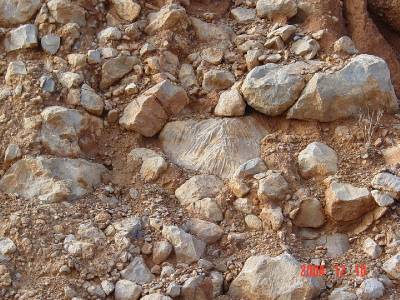
Fig. 3. The regmaglypted individual embedded in the Puerto Mínguez impact ejecta is incompatible with an in situ dissolution (“lapiés” formation).
Alternatively, the “lapiés” depressions existed already before the impact and survived rock fracturing, excavation, and emplacement of the ejecta. This can be excluded because many clasts are regmaglypted all around (Fig. 4), and the frequently observed sharp-edged ridges of the regmaglypts (Fig. 4) would not have survived the excavation and ejection process.
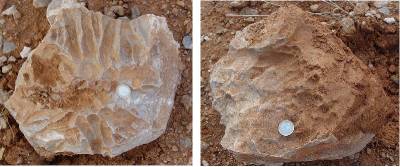
Fig. 4. Front and rear of a regmaglypted limestone clast from the Puerto Mínguez ejecta. The regmaglypts all around and the sharp ridges exclude a “lapiés” formation before excavation and ejection.
In a few cases, the ablation by obvious carbonate melting of the clasts has eaten deeply into the clast (Fig. 5) reminding of similar distinct ablation features of some meteorites (Fig. 6).
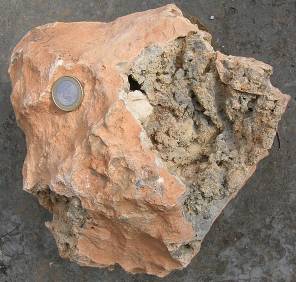
Fig. 5. A regmaglypted limestone clast from the Puerto Mínguez ejecta exhibits prominent ablation reaching deeply inside into the limestone clast. For comparison see the meteoritic ablation features in Fig. 6.
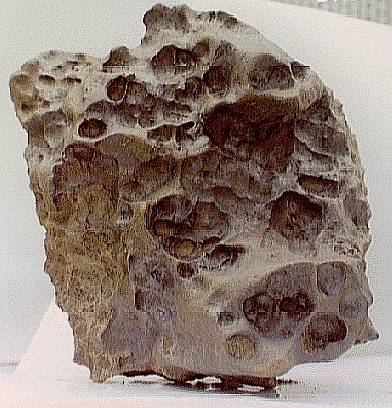
Fig. 6. The Derrick Peak, Antarctica, meteorite. Image courtesy of NASA.
An extended article on the Puerto Mínguez regmaglypted ejecta including many images can be read here.
Impact-affected limestone clasts with regmaglypts have been reported also from the Chiemgau impact. An article may be clicked.
Cutting into an impact crater rim: excavation and modification signature of the impact cratering process
| Road constructors are the friends of the impact geologists. Without their work, most of the highlighting impact outcrops in the Spanish Azuara and Rubielos de la Cérida impact structures would not exist, and many of the rocks typifying impact would not have been discovered. In the last decade, kilometers and kilometers of new geological exposures have been prepared, and we mention the road cuts between Luco de Jiloca and Lechago, at the Puerto Mínguez, between Navarrete and Barrachina, between Fuendetodos and Azuara, between Lécera and Muniesa, between Fuendetodos and Jaulín, and many more. Not only the road cuts but also the many new quarries mostly exploited for road construction material have supplied new geologic outcrops of high geologic importance, as for example the quarries between Belchite and Puebla de Albortón, the many temporary quarries between Navarrete and Barrachina, the large quarries of Corbalán, San Blas, Villafranca del Campo, near Muel, and so on.
The road cut at the crater rim and view down into the Rubielos de la Cérida impact basin. Only recently, the new road cutting into the Rubielos de la Cérida impact basin rim in the ascent between Alfambra/Escorihuela and El Pobo/Cedrillas has prepared a breath-taking extraordinary continuous geologic exposure of currently about 2 km length. The exposure does not show only the unimaginably disastrous forces of the impact excavation and modification of the Permotriassic/Buntsandstein and Muschelkalk rocks leaving a gigantic megabreccia, but also reveals large-scale rock deformations hitherto obviously unknown to geologists. We want to call them stop-and-go deformations.
The impact stop-and-go deformation is characterized by a multiple rapid sequence of erosion, sedimentation, folding, faulting and flow in a limited rock unit. This extremely peculiar process is not explicable by “normal“ geological forces and is understood only by the complex impact excavation and modification movements with permanently and in a short time strongly varying stress fields probably supported by the action of water and shock-produced volatiles.
Simple model of stop-and go deformation.
More stop-and-go deformations: megabreccia near Barrachina. Also see https://www.impact-structures.com/impact-spain/the-rubielos-de-la-cerida-impact-basin/megabreccias/ |
|
|
|
|
The Jaulín impactite (Azuara impact structure, Spain)
About 30 km north of the center of the Azuara impact structure (Spain) near the village of Jaulín (0°59.3′ W; 41°27.2′ N), a peculiar breccia is exposed. The breccia, not mapped geologically thus far, is intercalated between fossil-rich Jurassic limestones and brownish Miocene(?) gypsum marls. The breccia is unconformably overlying the Mesozoic rocks (Fig. 1) and may penetrate the limestones (breccia dikes, Fig. 2) as well as corrode them (Fig. 3).
On cursory inspection, the greenish rock looks like a massive bone breccia (Fig. 4). On closer examination, the “bones” prove to be limestone clasts having become hollow or more or less completely skeletal (Figs.5, 6).
Beginning (Fig. 7) and complete fragmentation of the clasts is observed. Beside these decomposed clasts, fragments of the limestone host rock are intermixed in the breccia (Fig. 8). They frequently show distinct whitish rims (Fig. 9) which we interpret as the result of beginning decarbonization from enhanced temperatures. Occasionally, the fragmented clasts remain coherent giving evidence of confining pressure upon emplacement (Fig. 10). For the present, it is not clear whether the hollow and skeletal clasts originate also from the local limestones, but from the discussion below we have to assume they are allochthonous.
The clasts are immersed in a greenish matrix (Fig. 8) partly exhibiting flow texture as indicated by lined-up small elongated clasts (Fig. 7). In thin section (Fig. 11), the matrix shows to be fine-grained carbonate streaked with irregular bands of poorly rounded quartz grains in a slightly different matrix. Quite a few quartz grains exhibit planar deformation features (PDFs) as in proof of shock metamorphism (Fig. 12).
Breccia formation. – The contacts between breccia and underlying autochthonous rocks as well as the peculiar characteristics of the clasts absolutely exclude a karstification process. A “normal” sedimentation and any diagenetic processes are not consistent with the observations either. From the stratigraphic position at the base of the unfolded Upper Tertiary and from the evidence of enhanced temperatures and of shock metamorphism we conclude the breccia to be an impactite related with the formation of the Azuara structure in the giant multiple impact event that, beside the Azuara structure, formed also the large Rubielos de la Cérida impact basin and crater chain (see https://www.impact-structures.com/spain/). We explain the breccia to be impact ejecta excavated from a region in the Azuara structure where shock intensities were enough to decarbonize and melt limestone cobbles and boulders and to produce PDFs in quartz grains contributing to the breccia matrix.
Fig. 13. Breccia sample impressively exhibiting internally corroded limestone clasts. Also note the finely splintered components.
Hollow and skeletal limestone boulders, cobbles and pebbles are not uncommon in the impact region, and they have been found in e.g. the basal suevite breccia (see suevite) and the impactite from Almonacid de la Cuba (see peculiarities). The process of the decomposition obviously confined to the interior of the clasts (see especially Fig. 13) is not completely understood thus far, but we suggest two possibilities that must not exclude one another. The clasts belonged to Lower Tertiary conglomerates in the target, and they experienced
- a shock concentration in the cobbles’ interior by shock-wave reverberation and focusing effects
and/or
- a shock heating of the cobbles and a rapid external cooling upon ejection, only allowing the interior to be decarbonized and melted.
On excavation and ejection, the shocked limestone clasts were mixed with the greenish matrix material possibly originating also from the Lower Tertiary. The emplacement was a process of ballistic erosion and sedimentation (Oberbeck 1975) under high pressure (penetration into the Jurassic host rock that was partially fragmented and incorporated into the breccia) and still enhanced temperatures (partial decarbonization of the host rock).
With regard to its stratigraphical position, the Jaulín impactite must be seen as a special variety of the Azuara/Rubielos de la Cérida basal breccia, and, due to the observed shock effects and the relics of probable carbonate melt, as a special type of a suevite breccia (see IUGS classification, the_suevite_page).
New varieties of the basal suevite breccia from the multiple-impact area in northern Spain
This peculiar polymict breccia uniformly exposed at the base of the unfolded Upper Tertiary over a distance of at least 120 km is a strong clue to the Mid-Tertiary multiple impact in northern Spain. A lot has already been said and written about this breccia (Ernstson & Fiebag, 1992; Ernstson & Claudin 2002, Ernstson et al. 2003; Claudin & Ernstson 2003; https://www.impact-structures.com/impact-rocks-impactites/the-suevite-page/suevites-from-the-azuara-and-rubielos-de-la-cerida-spain-impact-structures/, https://www.impact-structures.com/impact-spain/the-rubielos-de-la-cerida-impact-basin/basal-suevite-breccia-in-the-rubielos-de-la-cerida-impact-basin/), and that is why we confine ourselves to show some new varieties exposed about 2 km northeast of Olalla in the rim zone between the Azuara impact structure and the Rubielos de la Cérida impact basin. We point to the dominating Paleozoic and Triassic components, to the flow texture, to halos around many clasts, to the remarkable fitting of fragmented clasts, to breccias-within-breccias, and we think that some of the breccias are simply beautiful.
Here, we want to mention that regional geologists from the Zaragoza university and the Madrid Center of Astrobiology (Ángel Luis Cortés, Marcos Aurell, Enrique Diaz-Martínez, and others), which basically deny an impact in that region, consider this typical breccia a lacustrine sediment or even a conglomerate (Aurell et al. 1993; Cortés, Nov. 6, 2002, Heraldo de Aragón).
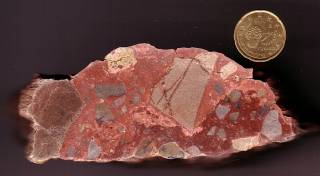
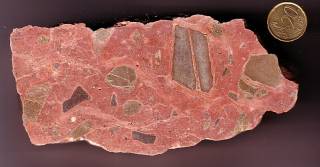
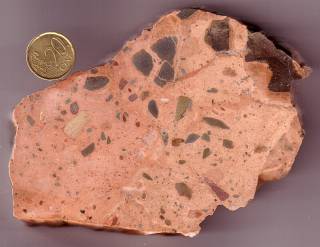
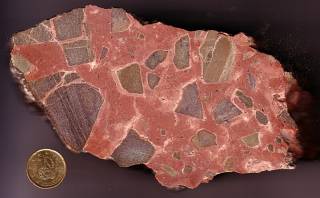
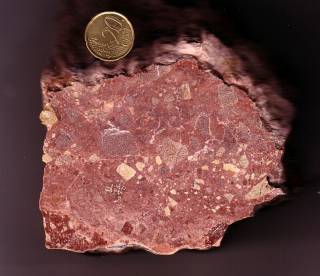
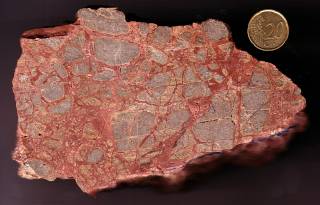
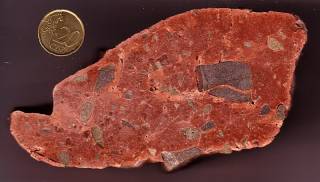







































































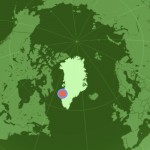
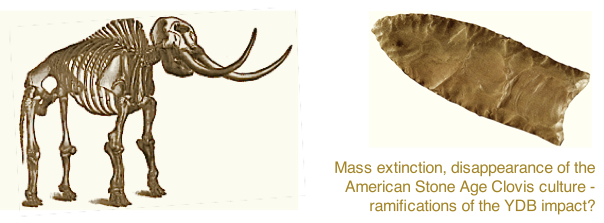

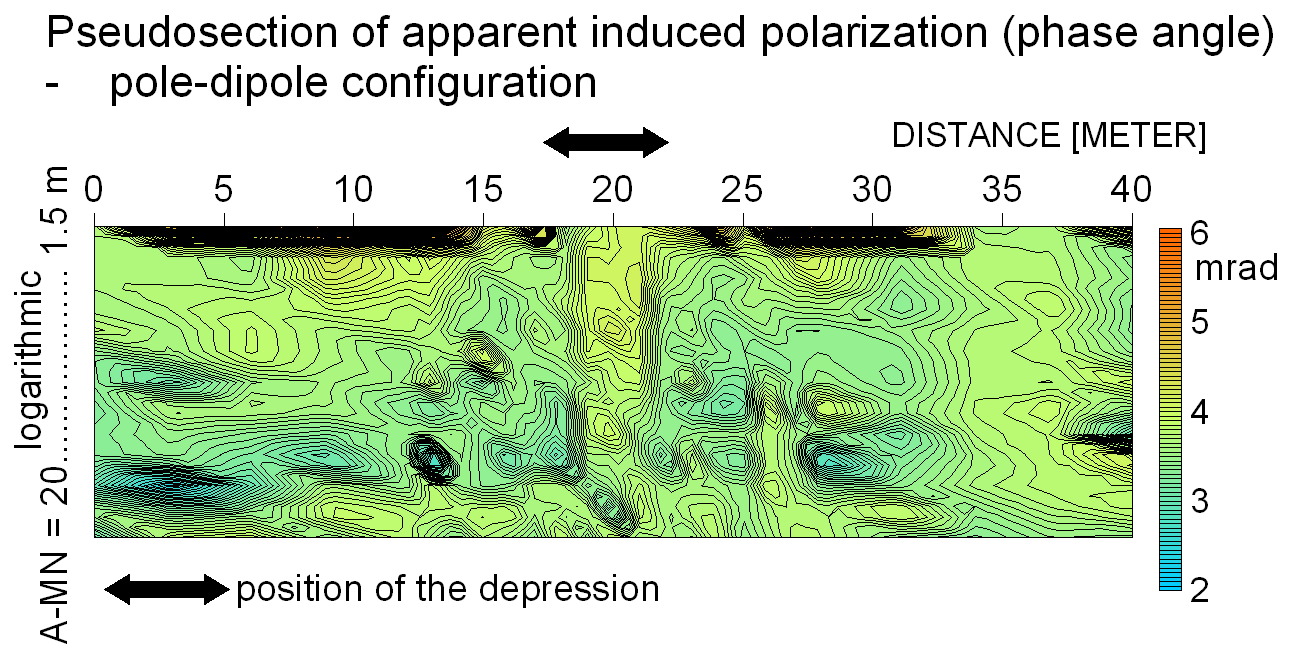
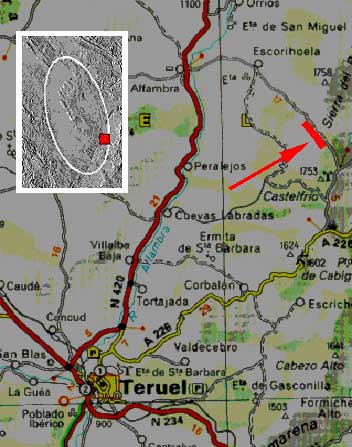 Location map.
Location map. 
